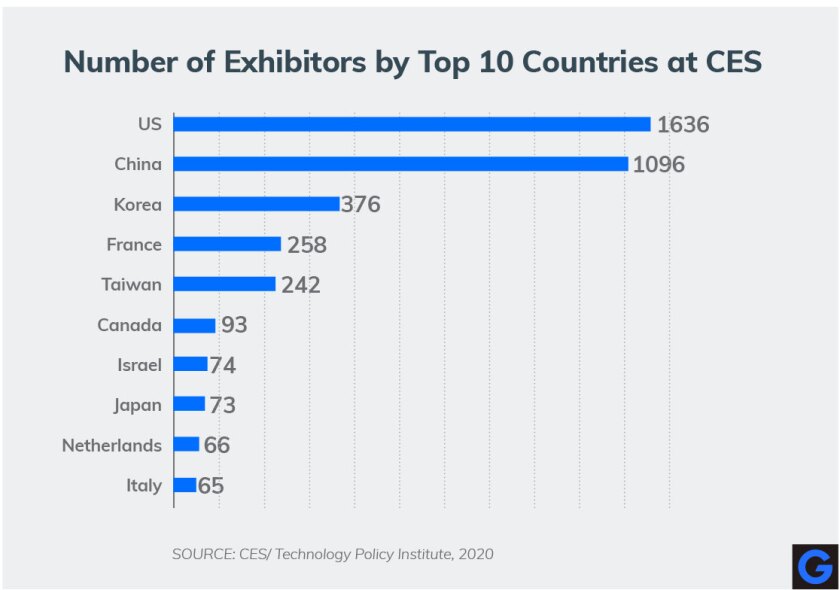The Technology Policy Institutecompiled an analysis of companies exhibiting at CES this year. Using this as a guide, we ranked six tech categories by number of exhibitors to provide some insight into topics public officials can expect to be dealing with in the year ahead.

Top 10 Countries Represented
CES also is the self-proclaimed “global stage for innovation,” drawing companies from over 60 nations. Despite the U.S. government’s restriction of Huawei and the newly announced software export restrictions, China continues to have a large presence at CES.
Deep Dive
Looking at two major categories from CES this year — smart home and vehicle technology — here’s a breakdown of the notable announcements from CES and why they are important for public officials.Smart Homes
Citizen experiences with consumer technologies have historically shaped their expectations for government agencies — and the smart home is where it all starts. Here’s what we saw in smart home technology at CES this year:- Voice assistants are everywhere. Voice assistants, such as Alexa and Google home, were embedded into even more consumer experiences this year in a wide range of categories — from vehicles to toilets. The rise of voice assistants creates opportunities for agencies to build new means for citizens to interface with government, but this will also need to be balanced by adaptive regulations ensuring privacy.
- Consumer facial recognition sneaks in. Facial recognition technologies were also embedded in numerous smart home devices, which will undeniably raise questions about how the data is being used and protected for consumers. The use of facial recognition by the government is already a hotly debated topic across the country, so it will be interesting to track how state legislators respond to the growing consumer use and adoption of the technology.
- Chatbots jump to video. Samsung announced a new “artificial human technology” called Neon, which it hopes to commercialize. Neon is not a digital assistant, but more like a video chatbot — that looks wildly real— that is designed to be used for more structured functions like customer service, teaching, and banking. We’ve seen chatbot utilization increase dramatically in government, so we’ll be watching to see if these video chatbots take off.
- Smart home access is hot, but is it the next big cybersecurity risk? We saw many new smart home access technologies launched, such as the August Wi-Fi Smart Lock, which enables a seamless experience of getting in the door when you get home while raising some serious cybersecurity questions that states may begin to regulate. Last year, California became the first state to regulate cybersecurity of Internet of Things (IoT)devices, which may be just the beginning of states becoming more involved in this aspect of regulation.
Vehicle Technology
Government agencies have historically had a love-hate relationship with new transportation technologies, and here are the vehicle technology trends that stood out this year at CES:- Lots of new modes of mobility. There were many new modes of transportation announced that may fall into an uncertain regulatory area, similar to the challenges presented by bike-sharing and scooters. Here are a few that stood out:
- Hyundai’s S-A1 eVTOL Flying Taxi for Uber
- Segway’s S-Pod Chair
- Cybic E-Bike with Alexa
- Honorable Mention - Sony Made a Car!
- Updated AV guidelines were released. The Department of Transportation released its updated guidelines for autonomous vehicles. Included in this fourth revision are three core foci for the development and integration of autonomous vehicles (also outlined through its Twitter thread):
- Protect Users and Communities
- Promote Efficient Markets
- Facilitate Coordinated Efforts
- New partnerships are accelerating change. Many new transportation partnerships were announced at CES 2020, but one standout one was between Nvidia and Audi, who together seek to release a Level 4 autonomous vehicle to market in 2020. This is notable because it shows the market timelines are exponentially faster than those that the regulatory environment can keep up with.
- Elected officials are getting more involved in emerging tech. Elected officials and government executives are pushing to be “test-beds” of new transportation technologies, such as what Betsy Price, mayor of the city of Fort Worth, Texas, spoke on regarding the launch of a new Mobility Innovation Zone.
- Autonomous is the future of public transportation. Rather than just planning more efficient routes and apps for citizens accessing service, one CES panel discussed why government agenciesshould plan for the future of public transportation as being autonomous.
Privacy – A Final Note
One of the leading trends at CES was not a product but an issue: privacy. Privacy is an increasing focus for state and local government, leading to new C-level positions and legislation to protect consumers and their data. Here are some of the notable privacy announcements from CES this year:- Apple showed up to talk privacy. For the first time in 28 years,Apple returned to CESto talk about the importance of privacy with other industry attendees. It was a notable move demonstrating the significance privacy will have for the consumer electronics industry — and most likely to increase industry collaboration in what has been a fragmented regulatory landscape.
- Ring revamps privacy and security features. After facing major backlash following the compromise of Ring security camera accounts, the company founder and CEO showed up to talk about a new dashboard that will be added to increase account security and simplify privacy controls for managing recordings.
- Google will let users easily erase recordings. Google announced a new set of privacy features for its products, including the ability to tell your Google Assistant to forget what it just heard.








